Marriage with a Twin Comes with a Warning Label
I’d like to share an excerpt from a reader who responded to a blog post that I wrote about the possible struggles of getting involved romantically with a twin. Now, as we all know, there are two or more sides to every story. What she wrote reflected solely what she experienced:
Please, can you put together a story for the partners of identical twins explaining the turmoil we have to endure and any coping strategies you can suggest.
I’ve recently separated from my 60-year-old identical male twin for the second time. His connection with his twin brother is pathological. In some cultures, twins are separated at birth. I understand why. I am deeply traumatised from the experience and now cannot look at twins in the same way. I feel they are cursed and should come with a warning to potential partners. Never again.
While this is an extreme perspective, it reminds me of a conversation I had a few months ago with a gentleman who had recently married a twin. Like many others—parents, psychologists, educators, and twins themselves—he did not understand how his wife’s twinship might affect their marriage. He just assumed that twins are good friends, and he looked forward to getting to know his sister-in-law. Unfortunately, several misunderstandings occurred among the three of them have. To his surprise, his wife sided with her twin against him. He felt blindsided and confused. It never occurred to him to that the twin bond might represent a threat to his relationship with his wife.
Like many others, he did not know that issues between the twins might impact him. After he spoke about a few of the incidents, I suspected that his wife felt compelled to protect her twin so her sister would not become psychologically unstable. If she blamed the twin or held her responsible, their interaction might turn explosive.
Optimally, when one decides to marry a twin—or a singleton, for that matter—one should get to know the partner’s family. Our upbringing and close attachments say so much about who we are and what we may become.
Image courtesy of Victoria Goldveber (CC BY-SA 2.0)



My husband has a twin sister. It has been very difficult thru the years dealing with his twin. Shes either angry, jealous, possessive of my kids and husband or playing the victim and trash talking me to all the relatives. She has used many manipulation techniques to try and break up our marriage. I would highly recommend not marrying a twin.